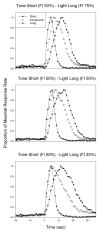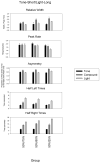Reinforcement probability modulates temporal memory selection and integration processes
- PMID: 23896560
- PMCID: PMC3903670
- DOI: 10.1016/j.actpsy.2013.06.006
Reinforcement probability modulates temporal memory selection and integration processes
Abstract
We have previously shown that rats trained in a mixed-interval peak procedure (tone=4s, light=12s) respond in a scalar manner at a time in between the trained peak times when presented with the stimulus compound (Swanton & Matell, 2011). In our previous work, the two component cues were reinforced with different probabilities (short=20%, long=80%) to equate response rates, and we found that the compound peak time was biased toward the cue with the higher reinforcement probability. Here, we examined the influence that different reinforcement probabilities have on the temporal location and shape of the compound response function. We found that the time of peak responding shifted as a function of the relative reinforcement probability of the component cues, becoming earlier as the relative likelihood of reinforcement associated with the short cue increased. However, as the relative probabilities of the component cues grew dissimilar, the compound peak became non-scalar, suggesting that the temporal control of behavior shifted from a process of integration to one of selection. As our previous work has utilized durations and reinforcement probabilities more discrepant than those used here, these data suggest that the processes underlying the integration/selection decision for time are based on cue value.
Keywords: Multimodal; Rats; Time perception.
© 2013.
Figures




Similar articles
-
Stimulus compounding in interval timing: the modality-duration relationship of the anchor durations results in qualitatively different response patterns to the compound cue.J Exp Psychol Anim Behav Process. 2011 Jan;37(1):94-107. doi: 10.1037/a0020200. J Exp Psychol Anim Behav Process. 2011. PMID: 20718546 Free PMC article.
-
Temporal averaging across multiple response options: insight into the mechanisms underlying integration.Anim Cogn. 2016 Mar;19(2):329-42. doi: 10.1007/s10071-015-0935-4. Epub 2015 Oct 31. Anim Cogn. 2016. PMID: 26520647 Free PMC article.
-
Timing in a variable interval procedure: evidence for a memory singularity.Behav Processes. 2014 Jan;101:49-57. doi: 10.1016/j.beproc.2013.08.010. Epub 2013 Sep 4. Behav Processes. 2014. PMID: 24012783 Free PMC article.
-
Temporal memory averaging and post-encoding alterations in temporal expectation.Behav Processes. 2013 May;95:31-9. doi: 10.1016/j.beproc.2013.02.009. Epub 2013 Feb 27. Behav Processes. 2013. PMID: 23454594 Free PMC article. Review.
-
Oscillation patterns of local field potentials in the dorsal striatum and sensorimotor cortex during the encoding, maintenance, and decision stages for the ordinal comparison of sub- and supra-second signal durations.Neurobiol Learn Mem. 2018 Sep;153(Pt A):79-91. doi: 10.1016/j.nlm.2018.05.003. Epub 2018 May 17. Neurobiol Learn Mem. 2018. PMID: 29778763 Review.
Cited by
-
Cognitive Aging and Time Perception: Roles of Bayesian Optimization and Degeneracy.Front Aging Neurosci. 2016 May 18;8:102. doi: 10.3389/fnagi.2016.00102. eCollection 2016. Front Aging Neurosci. 2016. PMID: 27242513 Free PMC article. Review.
-
Temporal scaling and computing time in neural circuits: Should we stop watching the clock and look for its gears?Front Behav Neurosci. 2022 Dec 8;16:1022713. doi: 10.3389/fnbeh.2022.1022713. eCollection 2022. Front Behav Neurosci. 2022. PMID: 36570701 Free PMC article.
-
5-HT1a Receptor Involvement in Temporal Memory and the Response to Temporal Ambiguity.Front Neurosci. 2018 Jul 3;12:439. doi: 10.3389/fnins.2018.00439. eCollection 2018. Front Neurosci. 2018. PMID: 30018532 Free PMC article.
-
Modeling Interval Timing by Recurrent Neural Nets.Front Integr Neurosci. 2019 Aug 28;13:46. doi: 10.3389/fnint.2019.00046. eCollection 2019. Front Integr Neurosci. 2019. PMID: 31555104 Free PMC article.
-
A Rescorla-Wagner drift-diffusion model of conditioning and timing.PLoS Comput Biol. 2017 Nov 2;13(11):e1005796. doi: 10.1371/journal.pcbi.1005796. eCollection 2017 Nov. PLoS Comput Biol. 2017. PMID: 29095819 Free PMC article.
References
-
- Burnham KP, Anderson DR. Model Selection and Multimodel Inference: A Practical Information-Theoretic Approach. 2. New York: Springer; 2002.
-
- Chamizo VD, Rodrigo T, MacKintosh NJ. Spatial integration with rats. Learning & Behavior. 2006;34(4):348–354. - PubMed
-
- Cheng K. A purely geometric module in the rat’s spatial representation. Cognition. 1986;23(2):149–178. - PubMed
-
- Cheng K. The vector sum model of pigeon landmark use. Journal of Experimental Psychology: Animal Behavior Processes. 1989;15(4):366–375.
Publication types
MeSH terms
Grants and funding
LinkOut - more resources
Full Text Sources
Other Literature Sources
Medical
Research Materials

